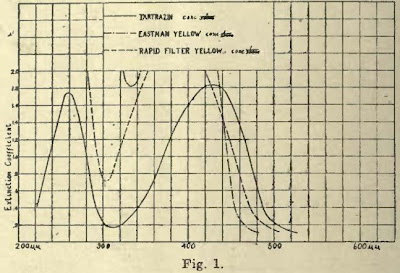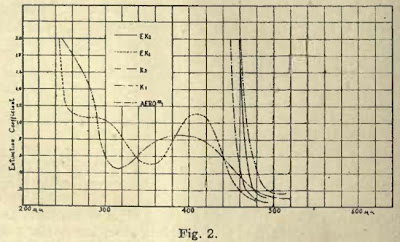In the early days of orthochromatic photography the dye generally used for the preparation of light filters was picric acid, this having the advantage of simplicity and cheapness and of great efficiency, picric acid absorbing the ultra-violet almost completely, and having a wry sharp cut in the spectrum. The disadvantage of picric acid, however, is that it is unstable to light, filters made with it soon turning brown. For this reason the early gelatine filters were made chiefly with tartrazine, which is very stable and gives permanent niters. Tartrazine, however, has the disadvantage that its absorption in the ultra-violet is unsatisfactory, and even moderately deep tertrazine filters transmit appreciable amounts of ultra-violet, this detracting very much from their efficiency. For this reason filter yellow, introduced by Hoechst in 1907, rapidly displaced tartrazine as the best dye for filter-making, and has held that position ever since.
Filter yellow is extremely stable, absorbs the ultra-violet strongly with the exception of a transmission band at 300μμ, which, since it is absorbed by glass, is of little importance, and hat a satisfactorily sharp out for the preparation of orthochromatic filters. A disadvantage of filter yellow which has always been recognized, however, is the fact that its absorption curve was less sharp than that of picric acid, and for many purposes, especially the preparation of very light filters, a dye possessing the stability and ultra-violet absorption of filter K, but of greater sharpness of cut, would be desirable.
When the need for light-filters of high efficiency for aerial photography arose the need for such a dye became pressing, and we undertook a search for such a material. After a great number of trials it was found that suitable absorption and stability were possessed by the phenyl-glucosazones.
When certain sugars, such as glucose, are warmed with a solution of phenyl-hydrazine in dilute acetic acid, yellow precipitates are produced possessing definite crystalline structures, by which the sugars may be characterized. These yellow substances are known as osazones, those formed with phenyl-hydrazine being termed phonylosazones. On measurement of the absorption spectrum of glucose-phenylosazone it was found that the absorption curve was very sharp and extended far into the ultra-violet, and since the material is well known to be stable, it appeared that a dye prepared from it would possess the properties required for the preparation of light yellow filters.
Glucose-phenylosazone is insoluble in water, so that to obtain a dye it is necessary to have a salt-forming group present in the molecule, and to produce a dye suitable for use with gelatine it was desirable that this group should be an acid one. To obtain such a derivative of glucose-phenylosazone which will form salts with metals it is merely necessary to substitute for phenyl-hydrazine a derivative containing an acid group and condense glucose with it in the same manner. Several such derivatives were tried, and the most satisfactory result was obtained with glucose-phenyl-osazone-para-carboxylic acid. This was prepared in the following way:-
Para-nitrotoluene was oxidized to give para-nitrobenzoic acid. This was then reduced to para-aminobenzoic acid, which was diazotized, and gave para-hydrazino-benzoic acid or phenyl-hydrazrne-para-carboxylie acid. The glucosazone of this acid is a yellow crystalline compound insoluble in water and almost insoluble in alcohol. It forms a sodium salt which is extremely soluble in water, but which can be precipitated from concentrated solutions by the addition of alcohol, and this sodium salt of glucose-phenyl-osazone-para-carboxylic acid has been adopted by us for the preparation of light-filters under the name of "Eastman Yellow."

In Fig. 1 are shown the absorption spectra of tartrazine, filter yellow, and Eastman yellow, from which it will be seen that the Eastman yellow has a sharper cut than filter yellow, and almost as strong an absorption in the ultra-violet.
Light-filters prepared from it retain these characteristics, and these light-filters have been prepared and specified under the names of EK 1 and EK 2 light-filters. A special filter for aerial photography has been adopted by the American forces under the name of Aero No. 1.

Fig. 2 shows the absorption curves of these light-filters.
As regards stability, it was found on test that the new dye was not quite so stable to light as filter yellow, but was superior to all other yellow dyes tried, and its stability is amply sufficient for the preparation of light-filters, since it requires weeks of exposure to direct sunlight to produce a change even in the lighter-coloured filters.
C. E. K. MEES.
H. T. CLARKE.
Filter yellow is extremely stable, absorbs the ultra-violet strongly with the exception of a transmission band at 300μμ, which, since it is absorbed by glass, is of little importance, and hat a satisfactorily sharp out for the preparation of orthochromatic filters. A disadvantage of filter yellow which has always been recognized, however, is the fact that its absorption curve was less sharp than that of picric acid, and for many purposes, especially the preparation of very light filters, a dye possessing the stability and ultra-violet absorption of filter K, but of greater sharpness of cut, would be desirable.
When the need for light-filters of high efficiency for aerial photography arose the need for such a dye became pressing, and we undertook a search for such a material. After a great number of trials it was found that suitable absorption and stability were possessed by the phenyl-glucosazones.
When certain sugars, such as glucose, are warmed with a solution of phenyl-hydrazine in dilute acetic acid, yellow precipitates are produced possessing definite crystalline structures, by which the sugars may be characterized. These yellow substances are known as osazones, those formed with phenyl-hydrazine being termed phonylosazones. On measurement of the absorption spectrum of glucose-phenylosazone it was found that the absorption curve was very sharp and extended far into the ultra-violet, and since the material is well known to be stable, it appeared that a dye prepared from it would possess the properties required for the preparation of light yellow filters.
Glucose-phenylosazone is insoluble in water, so that to obtain a dye it is necessary to have a salt-forming group present in the molecule, and to produce a dye suitable for use with gelatine it was desirable that this group should be an acid one. To obtain such a derivative of glucose-phenylosazone which will form salts with metals it is merely necessary to substitute for phenyl-hydrazine a derivative containing an acid group and condense glucose with it in the same manner. Several such derivatives were tried, and the most satisfactory result was obtained with glucose-phenyl-osazone-para-carboxylic acid. This was prepared in the following way:-
Para-nitrotoluene was oxidized to give para-nitrobenzoic acid. This was then reduced to para-aminobenzoic acid, which was diazotized, and gave para-hydrazino-benzoic acid or phenyl-hydrazrne-para-carboxylie acid. The glucosazone of this acid is a yellow crystalline compound insoluble in water and almost insoluble in alcohol. It forms a sodium salt which is extremely soluble in water, but which can be precipitated from concentrated solutions by the addition of alcohol, and this sodium salt of glucose-phenyl-osazone-para-carboxylic acid has been adopted by us for the preparation of light-filters under the name of "Eastman Yellow."

In Fig. 1 are shown the absorption spectra of tartrazine, filter yellow, and Eastman yellow, from which it will be seen that the Eastman yellow has a sharper cut than filter yellow, and almost as strong an absorption in the ultra-violet.
Light-filters prepared from it retain these characteristics, and these light-filters have been prepared and specified under the names of EK 1 and EK 2 light-filters. A special filter for aerial photography has been adopted by the American forces under the name of Aero No. 1.

Fig. 2 shows the absorption curves of these light-filters.
As regards stability, it was found on test that the new dye was not quite so stable to light as filter yellow, but was superior to all other yellow dyes tried, and its stability is amply sufficient for the preparation of light-filters, since it requires weeks of exposure to direct sunlight to produce a change even in the lighter-coloured filters.
C. E. K. MEES.
H. T. CLARKE.
Tidak ada komentar:
Posting Komentar